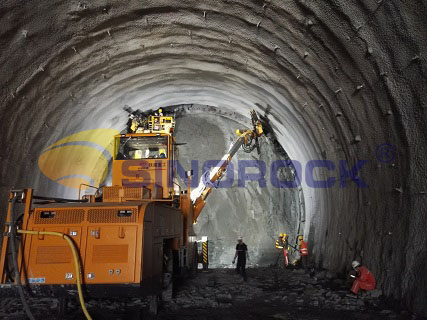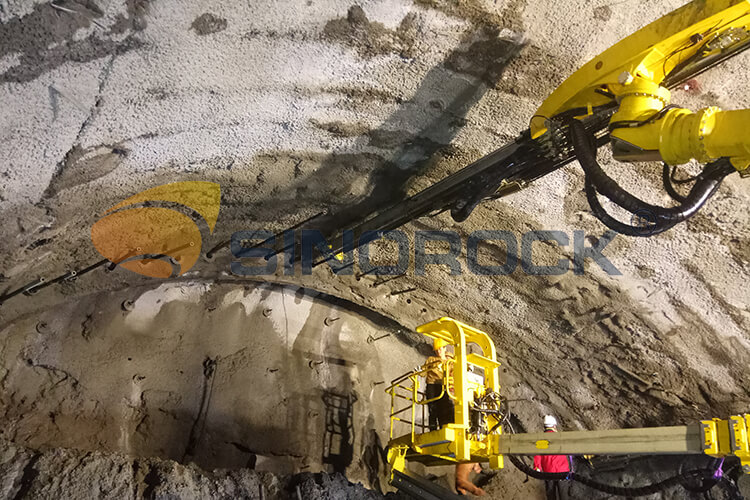How to Use Self Drilling Rock Bolts in Tunnel and Mining Constructions?
Time:2024-02-28From:sinorock View:
In the construction of excavation, such as tunnels, mining, and other underground projects, we have to support the soil and rock mass to ensure the people and equipment are safe. Generally, we use rock bolts to do this. Rock bolt has a long history of being used in tunnels and mines and now it is the turn of self-drilling rock bolts. Today, Sinorock will introduce you to how to use self-drilling rock bolts in tunnels and mining constructions.

Factors Affecting Rock Mass Stability
In the intricate world of tunneling and mining constructions, the stability of rock masses is paramount to ensure safety and longevity. Several factors significantly influence rock mass stability:
1. Lithology
The influence of lithology on rock mass stability includes two aspects. One is the influence of the physical and chemical properties of the rock on the stability of the rock mass, including the hardness of the rock and soil, weathering resistance, softening resistance, strength, composition, and water permeability. The influence of rock mass stability is reflected in the degree of development of joints and fissures and their distribution, the cementation of structural planes, the distribution of weak planes and fracture zones, etc.
2. Structure
Rock mass structure includes two aspects, structural plane and structural body. Structural planes refer to the differentiation planes and discontinuous planes of rock materials, planes, fractures, layers, bands and various geological interfaces with certain directions, scales, shapes and characteristics. The structure is composed of various structural surfaces of different occurrences, and the rock mass is cut into unit blocks. The rock mass structural factors that affect the stability of rock mass mainly include the inclination, dip angle and strike of the structural plane, the number and continuity of the structural plane and so on.
3. Surface Water
The impact of surface water on the rock mass is small because the rock mass has high strength and is not easily eroded. However, if the rock is severely weathered and the rainfall intensity is high, the influence of surface water on the stability of the rock mass cannot be underestimated.
Types of Rock Bolts in Tunnel and Mining
Understanding the diverse range of rock bolts is crucial for tailoring support systems to specific geological conditions. In the realm of tunneling, several types of rock bolts find applications:
1. Friction Bolts
Utilizing thin-walled steel pipes with longitudinal slits, friction bolts generate resistance against the radial pressure of the hole wall, providing stability and support in tunnels.
2. Expandable Rock Bolts
These bolts, crafted from specially shaped cavity rods processed with thin-walled steel pipes, expand through high-pressure water injection. This expansion generates frictional resistance on the hole wall, anchoring the rock mass effectively.
3. Pre-stressed Rock Anchors
This type of rock anchor can provide a pre-stress to prevent rock mass deformation. Through the anchoring force generated by the anchor head, certain pre-compression stress of the rock anchor is applied to the surrounding rock to actively strengthen the rock mass.
4. Self-Drilling Rock Bolts
The most widely used anchoring tools in geological constructions, self-drilling rock bolts integrate drilling, grouting, and anchoring in a single process. Suitable for broken rock and challenging drilling conditions, these bolts enhance construction efficiency by eliminating the need for casing pipes.
.jpg)
Benefits of Using Self-Drilling Rock Bolts in Tunnel and Mining Constructions
Self-drilling rock bolts offer a myriad of advantages, making them indispensable in tunneling and mining projects:
1. All-in-One Solution
The integration of drilling, grouting, and anchoring streamlines the construction process, enhancing efficiency and reducing operational complexities.
2. Versatile Drill Bits and Thread Hollow Bars
With a variety of drill bit options like EX, EY, ES-F, EXX, EYY, ESS-F, and clay bits, and two types of thread hollow bars (R thread and T thread), self-drilling rock bolts offer adaptability to diverse geological conditions and drilling rigs.
3. Accessibility in Narrow Spaces
The ability to cut or lengthen thread hollow bars at any position using couplers provides unparalleled convenience in supporting rock masses within confined spaces where large equipment cannot reach.
Step-by-Step Guide on How to Install Self-Drilling Rock Bolts
1. Preparation
Prior to drilling, ensure the drilling rig, rock bolts, and grout are ready. Connect the drill bit to the hollow bar, check for any blockages in the inner path, and connect the grouting pipe to the hollow bar.
2. Drilling and Grouting
Simultaneously start the drilling rig and grout machine. Drill and grout in unison, ensuring that the grout effectively strengthens the surrounding soil or rock mass.
3. Solidification and Installation
Allow the grout to solidify and then proceed to install the plate and nut, completing the self-drilling rock bolt installation process.
Application Structure of Self-Drilling Rock Bolt in Tunnels and Mining
In the realm of tunnels and mining, self-drilling rock bolts find extensive applications in various support structures:

1. Fore-piling
Used for initial support during tunneling, self-drilling rock bolts employ high-pressure grouting to strengthen soil or rock mass, ensuring stability during excavation.
2. Radial Support
These rock bolts provide essential support, reinforcing the radial aspects of the tunnel to withstand external pressures and maintain structural integrity.
3. Tunnel-Face Support
Self-drilling rock bolts play a pivotal role in supporting the tunnel face, ensuring safety and stability during the excavation process.
4. Locking the Foot Support
Employed to secure the foundation and prevent subsidence, self-drilling rock bolts contribute to the overall stability of the tunnel or mining structure.
5. Reinforcement of the Tunnel Portal
Ensuring the stability of the entrance or exit of the tunnel is crucial, and self-drilling rock bolts are instrumental in reinforcing the tunnel portal.
Conclusion
Mastering the art of using self-drilling rock bolts in tunnel and mining constructions is key to achieving optimal stability and safety. With a deep understanding of rock mass stability factors, types of rock bolts, and installation guides, engineers and professionals can navigate the challenges of geological construction with confidence. The versatile and efficient nature of self-drilling rock bolts continues to make them a cornerstone in the toolkit of tunneling and mining projects, unlocking the potential for safer and more robust underground structures. For further inquiries or product needs, contact us at sinorock@sinorockco.com, and our team will respond promptly to assist you.
latest news
-

- What Are the Applications of SDA Bolts in Hydropower Stations?
- Time:2025-08-21From:This Site
- Learn how self-drilling anchor bolts enhance slope stability, tunnel support, and dam reinforcement in complex geological conditions at hydropower stations. Optimize hydropower projects with efficient, cost-effective, and eco-friendly solutions.
- View details
-

- Slope Stabilization with SDA Bolts: Benefits & Applications
- Time:2025-08-19From:This Site
- Discover how self-drilling anchor bolts (SDA bolts) provide superior slope stabilization for highways, railways, and tunnels. Learn their key benefits, installation process, and real-world applications in loose or collapsible soils.
- View details
-

- How Self-Drilling Rock Bolts Enhance Tunnel Support in Fractured Rock?
- Time:2025-08-15From:This Site
- Discover how self-drilling rock bolts enhance tunnel support in fractured rock. Learn their benefits, installation steps, and real-world applications for safe, efficient tunneling.
- View details
-

- Sinorock 2025 Quality Month | Strengthening Quality Foundations, Empowering Product Excellence
- Time:2025-08-13From:This Site
- Sinorock’s 2025 Quality Month, themed “Strengthening Quality Foundations, Empowering Product Excellence,” successfully concluded, reinforcing our commitment to superior product quality.
- View details
-

- Sinorock Safety Month 2025 | Everyone Speaks Safety, Everyone Can Respond
- Time:2025-07-03From:This Site
- Sinorock Safety Month 2025, centered on the theme "Everyone Speaks Safety, Everyone Can Respond - Spot Workplace Hazards," has wrapped up successfully!
- View details
-

- Quality Control: the Vital Factor of A SDA Bolt Factory
- Time:2025-01-09From:This Site
- Sinorock’s comprehensive quality control system, from supplier management to outgoing inspections, ensuring the highest standards for self-drilling anchor bolts in construction.
- View details
-

- Sinorock Invites You to Explore Proven Self-Drilling Anchor Bolt Solutions at bauma 2025
- Time:2025-03-07From:This Site
- From April 7–13, 2025, explore Sinorock’s Self-drilling anchor bolt solution at Booth C2.513/4 in Hall C2 of the Messe München Exhibition Center (Munich, Germany).
- View details
-
.jpg)
- SINOROCK to Attend EXPOMINA PERÚ 2024 in Lima, Peru
- Time:2024-08-10From:This Site
- Sinorock to Attend EXPOMINA PERÚ 2024 in Lima, Peru
- View details
-
.jpg)
- SINOROCK to Participate in MINING AND METALS CENTRAL ASIA 2024
- Time:2024-08-08From:This Site
- SINOROCK to Participate in MINING AND METALS CENTRAL ASIA 2024
- View details
 Download
Download 


